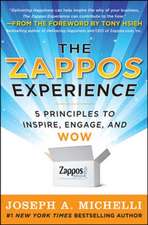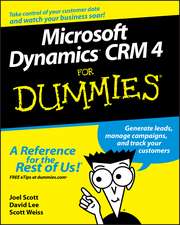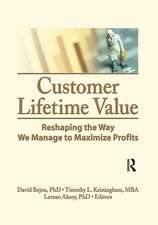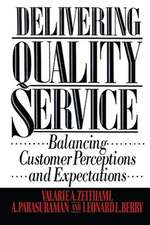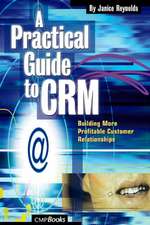Service Breakthroughs
Autor James L. Hesketten Limba Engleză Paperback – 11 sep 2007
firms that changed the rules of the game in their respective industries by consistently meeting or exceeding customer needs and expectations. To find out how these companies do it, service management experts James Heskett, Earl Sasser, and Christopher Hart put the question to the chief executive officers of fifteen of America's leading service firms attending a workshop at the Harvard Business School. Breakthrough leaders, they discovered, think very differently about their businesses than do their competitors, in distinct and well-defined ways. Now, in Service Breakthroughs, based upon five years of exhaustive research in fourteen service industries, Heskett, Sasser, and Hart show exactly what enables one or two companies in each industry to constantly set new standards for quality and value that force competitors to adapt or fail.
At the heart of breakthrough performance, the authors contend, is a sometimes intuitive
but thorough understanding of the "self-reinforcing service cycle" that replaces traditional management of "trade-offs." The "cycle" is a paradigm derived from the research results suggesting direct links between heightened customer satisfaction, increased customer retention, augmented sales and profit, improved quality and productivity, greater service value per unit of cost, improved satisfaction of service providers, increased employee retention, and further heightened customer satisfaction. With detailed examples and dramatic case studies of Mark Twain Bancshares, American Airlines, Florida Power & Light, Federal Express, McDonald's and many other companies, Heskett, Sasser, and Hart show how this self-reinforcing cycle of behavior differentiates breakthrough leaders from their "merely good" competitors.
The authors describe how breakthrough managers develop counterintuitive, even contrarian, strategic service visions. These companies define their "service concept" in terms of results
achieved for customers rather than services performed. They target market segments by focusing on
psychographics -- how customers think and behave -- instead of demographics. And instead of viewing a
service delivery system as a facility where the service is producted and sold, breakthrough firms see it as an opportunity to enhance the quality of the service.
These profound differences in thought and action have brought spectacular results. For managers who wish to set the pace in their service industries, Service Breakthroughs will be essential reading.
Preț: 131.88 lei
Nou
Puncte Express: 198
Preț estimativ în valută:
25.24€ • 26.25$ • 20.84£
25.24€ • 26.25$ • 20.84£
Carte disponibilă
Livrare economică 22 martie-05 aprilie
Preluare comenzi: 021 569.72.76
Specificații
ISBN-13: 9781416576860
ISBN-10: 141657686X
Pagini: 306
Dimensiuni: 152 x 229 x 25 mm
Greutate: 0.46 kg
Ediția:07000
Editura: Free Press
Colecția Free Press
ISBN-10: 141657686X
Pagini: 306
Dimensiuni: 152 x 229 x 25 mm
Greutate: 0.46 kg
Ediția:07000
Editura: Free Press
Colecția Free Press
Notă biografică
James L. Heskett teaches at the Harvard Business School.
Cuprins
Preface Acknowledgments
1. Creating Breakthrough Services
2. Developing a Vision of the Business
3. Building Customer Loyalty
4. Focusing and Positioning the Service
5. Determining the True Costs and Benefits of Service Quality
6. Developing Devices for Achieving Total Customer Satisfaction
7. Managing for Quality and Productivity Gains
8. Managing Demand and Supply
9. Managing Networks
10. Managing Information Technologies
11. Mobilizing People
12. Organizing Work
13. Conceiving Future Breakthroughs
14. Realizing Service Breakthroughs
Appendix: Illustrative Approaches to Transportation Network Design
Notes
Index
1. Creating Breakthrough Services
2. Developing a Vision of the Business
3. Building Customer Loyalty
4. Focusing and Positioning the Service
5. Determining the True Costs and Benefits of Service Quality
6. Developing Devices for Achieving Total Customer Satisfaction
7. Managing for Quality and Productivity Gains
8. Managing Demand and Supply
9. Managing Networks
10. Managing Information Technologies
11. Mobilizing People
12. Organizing Work
13. Conceiving Future Breakthroughs
14. Realizing Service Breakthroughs
Appendix: Illustrative Approaches to Transportation Network Design
Notes
Index
Extras
Chapter 1
Creating Breakthrough Services
Outstanding service organizations are managed differently from their merely good competitors. Missions are stated differently. Managers act differently. Actions are based on totally different assumptions about the way success is achieved. And the results show it, both in terms of conventional measures of performance and the impact these services have on their competitors.
Recently one of us visited the Tyson's Corner Mall in northern Virginia. The visit resulted in one surprise after another as salespeople in large stores and small exhibited unusual interest in providing unexpectedly outstanding service. At first we attributed it to Southern hospitality. But the experience wasn't consistent with others we've had in the same area. And then it dawned on us. Among the four department stores which the huge mall contained, one was Nordstrom. And Nordstrom's level of service exceeded even that provided by other retailers that same day. The experience was a clear reflection of a strong conviction often expressed by Nordstrom's service managers that a store manager's primary responsibility is to satisfy customers.
Naturally, we had seen many of the things written about the high level of service provided by this fashion retailing organization. But we had not witnessed the impact it could have on an entire shopping center, one of the largest in the United States. The experience triggered a line of thinking about those one or two firms in every service industry that stand out from the pack. Firms that seem to gain momentum, almost as if they are propelled by an added force not available to their competitors. Firms that seem to have broken through some sort of figurative "sound barrier," that have passed through the turbulence that precedes the barrier into the relatively quiet, smooth zone beyond in which a management action produces exaggerated results, results that often exceed reasonable expectations. Firms that alter the very basis of competition in their industries.
We began to think of the offerings of these firms as breakthrough services and set out to try to capture in words, numbers, and diagrams the essence of what managers do to break the figurative sound barrier.
We started with three simple, beliefs: (1) it is possible to manage a good firm through the barrier that distinguishes the good from those that are moving beyond Mach 1; (2) outstanding services and the firms that provide them are made, not born; and (3) breakthrough services managers don't think like their merely good counterparts in competing organizations.
Having tested these ideas through numerous field observations, we are convinced more than ever that our starting beliefs hold up. But we have found out a great deal more along the way about how managers think and act in designing and delivering breakthrough services. They invariably start with the service encounter.
THE SERVICE ENCOUNTER
At the heart of every service is the service encounter. Everything flows from it. A service encounter, is the event at which a customer comes into contact with a service provider, its people, its communications and other technology, and the services it provides. It is the point in time at which especially marketing, operations, and human resource management are brought to bear on the process of creating and delivering a service that meets customers' needs, perceived risks, and expectations. It has been termed by Jan Carlzon, CEO of SAS (Scandinavian Airlines System), the "moment of truth" at which the representatives of a service company must prove to their customers that their company is the best alternative.
The most important relationships in a service encounter, based on research done to date, are summarized in Figure 1-1. We have purposely been selective in choosing elements of this model. The first is based on research findings; the others follow from it. They are:
1. The quality of service (customer satisfaction) = service quality delivered - service expected.
2. The value of a service to a customer = service quality (both the results realized and process by which they were achieved) divided by (price and other customer costs of acquiring the service).
3. Potential profit "leverage" in providing the service = value to the customer - cost to the service provider.
4. The profitability of a service to its provider = margin x repeat usage ÷ investment.
It occurred to us that most service managers understand these relationships. Why then do so few use this understanding to produce services that achieve true competitive superiority? The primary reason, we've concluded, is that most view these relationships as a set of trade-offs to be designed and managed in traditional ways that have been handed down from one generation of operating manager to the next for years. This is the view that assumes that nearly all decisions involve trade-offs. That higher quality requires greater investment or higher costs, or that lower costs naturally are associated with lower quality. That higher prices naturally reduce demand. And that the primary avenue to higher profits is higher margins. While these assumptions ignore the way in which customers assess the value of a service, they represent conventional, accepted management thinking.
Breakthrough managers look at the same relationships and see something else. They see the service encounter as a dynamic force with a potential for fueling a set of Self-reinforcing relationships shown in Figure 1-2. They take advantage of relationships that propel a firm through the competitive sound barrier, often by defying conventional logic concerning trade-offs. These managers spend less to achieve higher value and higher margins. They lower prices to increase margins. They raise prices and sell more. They understand customer value, quality, and ways of leveraging value over cost. Most important, they understand how to develop fanatical loyalty among customers, employees, suppliers, and investors, loyalty that produces the flow of results bordering Figure 1-2. In short, they frequently astound and often confuse their merely good competitors, who work just as hard but end up being second- or third-best.
Consider, for a moment, the underlying policies of Nordstrom and how management implements them. As we said earlier, everything flows from the mission of providing outstanding service to customers. The way this is achieved is by stocking fashion merchandise in greater depth and breadth than competitors; having pleasant, well-located stores; providing incentives to salespeople and managers to deliver superior service to customers; and then leaving it up to individual store managers and salespeople as to how superior service is to be achieved.
Merely good competitors whose managers practice by the "trade-off" philosophy look at Nordstrom and shake their heads. Because Nordstrom has more complete stocks of fashion merchandise, its inventory carrying costs should be higher than industry averages, right? Wrong. Nordstrom's inventory carrying costs in relation to sales are not higher. Well-designed stores in good locations featuring such amenities as live music performed on a grand piano in each store have to result in higher overhead and occupancy costs than for competitors, right? Wrong again. Nordstrom's overhead and occupancy costs in relation to sales are not higher. Because Nordstrom relies heavily on sales commissions, paying successful salespeople roughly twice as much as they could make at its most serious competitors' stores, it must have the highest labor costs in the industry, right? Still wrong. In relation to sales, Nordstrom's labor costs are at or below industry averages. Delegating the control of service quality to the point of sale must involve risks of achieving highly uneven service quality, right? The evidence suggests not. Nordstrom has one of the most fiercely loyal group of customers of any firm anywhere. Most are recruited by word-of-mouth referrals, thus reducing advertising costs to one of the lowest levels of all fashion retailing firms.
The results of Nordstrom's breakthrough service are mirrored not only in the company's loyal customers but also in its high productivity of assets and personnel; in its ability to retain experienced, capable people; and in its substantial profit on investment even while growing rapidly. At the heart of Nordstrom's success is an understanding of not just how to deliver value to customers or how to control costs, but rather how to leverage value over cost to achieve profit.
LEVERAGING VALUE OVER COST TO ACHIEVE PROFIT
The difference between the value of a service to a customer and the cost of providing it determines profit potential. It is what we call profit leverage. The extent to which it is fully captured by the service provider depends on its pricing policy.
VALUE OF SERVICE
What we receive for what we pay is the basis for measuring value in services as well as products. Our perception of what we receive in a service, however, is based both on results obtained and the manner in which the results are achieved.
Quality of Service. Results and the process by which they are delivered are the components of what we call service quality.
Results from a service often are difficult to assess. As Valarie Zeithaml has pointed out, it is hard to know the results even after we have purchased many services. In contrast, we see the result immediately when we try on a piece of clothing or wear it in public for the first time. We can get some idea of the potential result before we buy. Other goods and many services are harder to assess in advance. For example, we have to have our hair styled to know whether we received good results from the hair stylist. It's nearly as hard to correct a bad haircut in process as it is to reverse it after the fact.
With many services, including almost all educational (this book, for example), medical, legal, and other professional services, the problem is even more extreme. We don't know the results even after the service has been performed. Astute service providers understand this and take measures to assure us that the result will be a good one, often through the process by which the service is delivered.
While we may not be able to assess results before, during, or even after some services, we frequently are able to observe how a service is delivered. This is why outstanding service organizations devote as much attention to the manner of service delivery as to the achievement of desired results.
Quality = Actual Service - Expected Service. Results and process, and thus quality, are evaluated by customers in terms of what they actually receive in relation to what they expected. Because needs and expectations vary by customer and situation, service quality is a highly subjective matter. Clearly, the customer defines quality.
Absolute measurements of service quality that do not include customer expectations miss the point. Customers have different expectations of the quality they can expect from different types of service providers, competitors within the same industry, and the same providers at different points in time and under varying conditions. This helps explain why customers regularly rate auto service quality at such chain organizations as Sears, Firestone, and Midas Muffler higher than at their authorized General Motors, Ford, or Toyota dealers. They expect more from the latter. And because they save their complex auto "medical" problems for the authorized dealer, they do not always come away satisfied. They expect only to get a muffler replaced at a certain price at Midas and it happens.
Customers often expect more rapid response from a Federal Express representative than they do from their doctor. Why? They have been conditioned to believe that the doctor is busier and a scarcer resource, whether it is true or not. One organization, Au Bon Pain, a French bakery café chain featuring sandwiches made with croissants, organized a "Moments of Truth" quality excellence program. As a result, it established several standards, including one borrowed from McDonald's, that no customer should wait more than two minutes in line to place an order. This standard, however, was modified to three minutes when customers indicated that they didn't expect Au Bon Pain to be as fast as a McDonald's because the food being served obviously took longer to prepare.
Customers expect better service from a firm that has provided good service in the past than one that has not, suggesting the importance of a series of service encounters and results over time. And customer expectations may or may not take into account the impact of peak or slack business times on the quality of service or the fact that they may buy different classes of service from the same provider from time to time. Thus, airlines serving travelers who use first class on business but who are traveling coach class with families on vacation regularly run the risk of being perceived as offering poor service, suggesting the need to find ways of making available some form of "first-class" vacation travel to those customers and their families.
Breakthrough service managers understand that a high-quality service encounter raises expectations for future encounters, not only those involving a customer with the same service company, but also those of its competitors. Thus, it is both a competitive weapon and a prod for continued service improvement. In a sense, high-quality service is its own best competition. The term "personal best," sought by competitive track and field athletes, applies in successful service firms as their customers' expectations are ratcheted upward and they strive to meet or exceed them with new features, variety, and positive service "surprises."
This ratchet effect may vary from one targeted customer segment to another, however. For years, the success of McDonald's has been based in part on the fact that one of its primary customer targets, children, typically do not want change from one encounter to another. They want the successful experience repeated exactly as it was the last time, whether or not their dutiful parents concur.
Perceived service quality can be enhanced both through efforts to improve results produced for customers and through efforts to condition their expectations about the nature of the service encounter and the results it might produce. Both are important.
One of the major themes of this book is service improvement. But we shouldn't overlook the fact that many services are enhanced through the conditioning of expectations. The medical profession, for example, has done a masterful job of enhancing value of service perceptions by conditioning prospective patients to expect to be treated like small children, told little, accept much of what happens to them on faith, and not be disappointed with failures to correct medical problems.
One progressive hospital manager, Erie Chapman, CEO of the U.S. Health Corporation, compares the situation of hospital patients unfavorably to that of prison inmates. In his view, both are subjected to excessive questioning, stripped of their usual clothing and possessions, placed in a subservient, dependent relationship to those attending to them, and allowed visitors only during certain hours. His organization is trying to do many things to correct this, including the creation of patient advocates and the designation of liaison people between staff and patients. But the fact is that today medical practitioners who exceed even by a small margin minimal expectations which have been established are regarded as delivering outstanding service.
In a less critical service encounter, a restaurant customer may be told to expect a 30-minute wait and then called to a table in only 20 minutes. Given the conditioning of expectations, the result can be a positive perception of service quality even at the end of a 20-minute wait.
Firms that raise customers' expectations before developing the ability to meet them may experience short-term sales gains and long-term customer losses. This may help explain why Delta Air Lines modified its slogan, "Delta is ready when you are," and why Holiday Inn did the same with its advertising campaign stressing, "No excuses. Guaranteed."
High-value service results in part from high quality. But service value has another component, cost. This includes both the price of the service and the less easily measurable costs of acquiring it.
Costs of Service to Customers. The traditional view of service acquisition costs is that they are all viewed negatively by the customer and thus have to be "traded off" against increased quality for the same or lower prices.
For example, Levitz Furniture pioneered the concept of the furniture warehouse store, one in which customers purchase from displays set up adjacent to a large warehouse stocked with crated furniture. In addition, customers may carry out their own purchases, thus reducing some of the most onerous costs of the furniture business, delivery and setup, with attendant damage to the product. This perhaps explains why Levitz offers a significant price incentive to customers to cart away their own purchases from the "warehouse."
Breakthrough services, in contrast, have been designed around the proposition that customers' perceptions of service acquisition costs are not all negative. Some of the most imaginative applications of this are provided by managers who understand that acquisition costs include the costs of delayed gratification, noninvolvement in the service, and lack of customer control over the result. This has led to the design of services incorporating more and more self-service, but at higher rather than lower prices of full-service competitors. In the case of furniture retailing, we are beginning to learn that for many customers, immediate access to their furniture has value. Further, they often ignore or underestimate acquisition costs, thus resulting in positive perceptions of the cost of self-service.
As one observer put it:
Many consumers are so convinced that self-service is the height of good service that they are willing to pay extra for the privilege -- witness the people who pay fees for using teller machines in New York, or who pay extra to tap into data systems through their own computers.
The Subjective Nature of Service Value. We have just observed that quality in services is subjective, defined by individual customers. At the same time, customers attach different costs to the same process of acquiring a service. As a result, service value, the difference between service quality and cost, for an identical service may vary a great deal from one customer to the next.
Excellence in service requires an understanding of customer needs and expectations. That perhaps explains the growing number of efforts to measure them. Even though these efforts have not all had the same objective, the results contain common patterns. British Airways, through such efforts, has found for example that nearly all travelers have the usual basic needs for convenient schedules, on-time service, and other physical elements of air travel service. But assuming these basic common needs are met, some travelers respond most positively to the care and concern shown to them in the delivery of the service. Others value highly the spontaneity with which front-line service staff deal with problems and requests. And still others look for and value the ability of service agents to solve problems and the skill with which they and their company respond when things go wrong.
Many differences in the value attached to services by customers are explained by the level of risk perceived by a customer in purchasing the service and the degree to which such risks can be minimized by the service provider. As humans, we are sensitive to many kinds of risks, including economic, social, medical, and legal risks. Our assessment of risk is based both on the likelihood and consequences of service failure. The likelihood of failure we perceive may result from the complexity of the service itself. Most of us view auto repairs involving mechanical problems as carrying higher perceived risks than an elevator ride. The consequences of failure might actually be greater in an elevator ride. But the likelihood of failure in repairing an auto is so much higher than riding an elevator that it may be viewed as riskier.
Breakthrough service designers and managers understand further that perceived risks also help explain why two customers value the same service differently. The difference often is explained by the amount of self-confidence, often associated with knowledge and expertise, that a customer brings to the service encounter. Thus, those with little mechanical ability often value auto repair services more highly than "weekend auto tinkerers." At the same time, auto repair value varies directly with the newness of the vehicle, its cost when purchased, and the value of time of its owner, reflecting both perceived economic and social risks.
Why is all of this important? Because customers associate value with efforts on the part of service providers to reduce economic, social, medical, legal, or other risks in achieving results that customers seek. That's why breakthrough services often make complex services seem simpler, help build customer self-confidence, and in the process achieve a level of reliability that helps insure that expectations regarding both service quality and cost are met.
This suggests the importance of managing customers' perceived risks designed to produce a range of expectations that the service provider can meet. It also suggests reducing customers' perceived risks and thus increasing their expectations in ways competitors cannot match, thus creating competitive advantage.
Outstanding service providers also seek consistency in the way basic elements of a service are provided. They meet and perhaps by a small margin exceed customers' expectations for the level of service provided. At the same time, they build expectations about the consistency with which the service is delivered. In addition, an effort may be made to enhance service over time by adding "surprises," in the form of noncritical service elements. For example, while the two commandments of the in-flight catering service business are: (1) thou shalt not cause a flight's departure to be delayed, and (2) thou shalt not damage the aircraft, efforts to upgrade the appearance of planeside personnel or assist in carrying out the on-board review of the accuracy of the delivery may help differentiate a superior, high-value in-flight kitchen.
COST OF SERVICE TO ITS PROVIDER
The cost of a service to its provider is influenced by, among other things: (1) the nature of the service offered to the customer, (2) the operating strategy of the service company, (3) its service delivery system, (4) the degree to which the server's capacity is utilized, and (5) the needs and attitudes of servers.
The first of these factors establishes a range of costs within which a service may be delivered. The development of an operating strategy and the design of a service delivery system further define the range of cost incurred, assuming a given level of capacity utilization. It then falls to the management of the service firm to both manage capacity and stimulate demand for it. But unless servers' needs are met and their attitudes toward service delivery developed, the finest operating strategy and service delivery system mean little. This underlines both the importance of the relationship between design and activation and the role of the manager in making it work. Because it is the subject of much of this book, we will only set the stage for our later discussion here by underlining one particular feature of Figure 1-2. It is the set of relationships between quality, productivity, cost, margin, price, value to customers, and increased repeat customer usage suggested by the arrows bordering the figure.
CREATING A SELF-REINFORCING SERVICE CYCLE VERSUS MANAGING TRADE-OFFS
Those who design and deliver service excellence are exposed to the same ideas as their less successful competitors. What is it, then, that they see and do that enables them to more successfully leverage value to customers over the cost of delivering a service? It is embodied in the relationships explaining the clockwise arrows around the border of Figure 1-2.
Service excellence is built first around an understanding that:
1. The value associated with the results a service provides and the quality of the way it is delivered depends on the extent to which a provider can reduce a customer's perceived risks.
2. Increased value in relation to the costs of acquiring a service leads to a higher probability that a customer will become a repeater.
3. Repeat customers, because they have established expectations, growing respect for the provider, and greater knowledge of what is expected of them in the service delivery process, are less expensive, and therefore more profitable to serve, than new customers.
4. The value of service to a repeat customer grows with the reliability of the way it is delivered and the results it achieves.
This leads rapidly to the conclusion that investments intended to build service reliability actually reduce the costs of service delivery while building value to customers. Investments in higher service reliability may take the form of greater care in the selection and training of employees, higher rewards for employees, the acquisition of superior technology or other elements of the service delivery system, and a single-minded emphasis on customer satisfaction, among others. The resulting improvements in both server satisfaction and motivation in turn are reflected in the quality and value of service to the customer, thus completing the "drive wheel" for the self-reinforcing service cycle, as shown in detail in Figure 1-3.
Why are so many of these investments made to attract and retain superior human resources? An important factor differentiating most service industries from manufacturing is the greater impact of the needs and attitudes of the service firm employee (the server) on the quality and value of the service delivered as well as its cost. Wages and salaries represent a much higher proportion of total costs in most service industries than in the manufacturing sector. Of greater significance, though, is the fact that in most service industries a much higher proportion of the total labor complement comes into direct or indirect (by telephone) contact with the customer than in the traditional manufacturing firm. For example, Robert Eccles and Dwight Crane have observed that in investment banking firms, "nearly all of the firm's professionals are directly involved with its environment, including customers, competitors, and experts in accounting, law, and taxes." The point of contact, of course, is the service encounter.
There is a growing body of evidence that suggests direct links between the satisfaction of the server, motivation to provide good service, the satisfaction of the customer, repeat sales, and profits. Contributing to the satisfaction of the server in this "cycle," pictured in Figure 1-3, are the satisfaction of the customer (thus completing the loop) as well as the service firm's policies concerning selection, development, and assignment of personnel; its efforts to measure performance, reward, and recognize people; and the physical and personal support services and facilities made available to the server at the time of the service encounter.
Nordstrom attracts managers and salespeople who want to work hard and get rewarded for it. Recruiting costs are very low because an unusually high proportion of applicants come to Nordstrom through referrals from current employees. Most training is on the job, carried out by successful employees. Because compensation of salespeople is by commissions on sales, the unsuccessful or those unable to stand the pace of work leave, and not always quietly. Those who stay communicate their enthusiasm to customers, a process that generates sales and reinforces Nordstrom's employee enthusiasm.
This self-reinforcing cycle of behavior is one of the reasons Nordstrom's customers get superior service. Another is that its salespeople and managers are charged with the mission of providing outstanding customer service and given the latitude to do so, in the process developing undying customer loyalty. Recently, for example, Nordstrom's senior managers at Seattle headquarters noted that hosiery sales at a West Coast store were several times those at other West Coast Nordstrom stores. Upon investigation, they found that an enterprising department manager had taken it upon herself to have her sales staff begin calling local offices during slack sales periods to inquire whether Nordstrom could deliver hosiery to busy secretaries who may have forgotten to replenish their supplies. Hosiery thus sold by telephone was immediately delivered by existing Nordstrom personnel. In the process, the precious time of salespeople was leveraged and the costly retail space in the store made much more productive. This is summed up in another of the frequently told stories that have made Nordstrom's service truly legendary. This one is told by a customer.
The customer pointed out to the Nordstrom salesperson that she had bought a pair of shoes at Bloomingdales that were too small for her. She liked the style, but Bloomingdales didn't have her size. After being fitted with the same shoe of the proper size, the customer started to pay for the shoes. The salesperson instead suggested that she merely take the too-small shoes in exchange for the new purchase. When the customer reminded the salesperson that she hadn't bought the first pair at Nordstrom, the salesperson said to her: "If I take these shoes for you, you won't have any reason to return to Bloomingdales."
Stocking broad selections of merchandise in attractive, well-located stores and providing incentives and the latitude to managers and salespeople to serve result in extraordinarily high sales productivity, both in terms of space and labor, at Nordstrom. This is the way that value is leveraged over cost at Nordstrom through a series of "margin-growing" activities.
These "margin-growing" activities pave the way for higher or lower prices, depending on competitive conditions. As a recent television advertisement for United Parcel Service says, "when you run at peak efficiency, you not only perform a better service but you have the luxury of charging less for it." Nordstrom's policy is not to charge less but to be competitive on all comparable merchandise, always meeting lower prices at competitors' stores. Both of these approaches can produce higher margins than those realized by merely good competitors.
Repeat customer usage of a service is central to the "drive wheel" shown in Figure 1-3. Much of what we've described results from it. Ordinary service providers take it for granted. Breakthrough companies give it unusual attention, carefully track it, and extensively nurture it.
CONCLUSION
The simple set of relationships that describe a service encounter as a positive self-reinforcing dynamic force in Figure 1-2 represents the result of a large number of "behind-the-scenes" decisions required to enhance the server's chances of achieving results desired by the customer. A successful service is the product of many small details, only some of which are the result of design and to some degree controllable. We are reminded of this every time we see a potentially disastrous customer relationship rescued by a remarkably perceptive and responsive human being exercising good judgment in a difficult situation. But wait a minute. How did that individual come to be affiliated with the service firm in the first place? How was the selection and assignment made? What part did training play in a seemingly fortuitous if difficult situation?
Interestingly, a successful service encounter most often appears to have less to do with compensation than a combination of loyalty to and belief in a company's service concept by a server and a reciprocal amount of trust in the server's ability to manage a service encounter effectively on a real-time basis by the company's management.
Such things as reciprocal loyalty and trust are built over time. They often are associated with both high quality and high productivity, in part resulting from the establishment of long-standing customer relationships and the sizable revenue stream they may represent. Just as important, they contribute to and result from close attention to the personal development of the server and resulting low turnover of staff, reinforcing high productivity and presenting added opportunity for high-quality customer encounters. In fact, service excellence is in large measure due to loyalty. The loyalty of employees to their customers, their company, and the service concept they are delivering. The trust of employees by a service company's management. And the loyalty of customers, employees, suppliers, and investors to a service provider.
This is the stuff of which breakthrough services are made for both customers and those who serve them. In exploring ways they are achieved in the remainder of the book, we'll be citing a number of examples drawn from firms we regard as breakthrough service providers in their respective industries, many of which are listed in Table 1-1. These firms provide evidence that service excellence pays off. As a group, they have achieved significantly higher rates of growth and higher returns on assets than the average for the largest firms in their industries, as shown in Table 1-2.
The major challenge to service firms that have achieved breakthrough performances is to meet the increasingly high expectations that they generate. They are held to a different standard than their "merely good" competitors. They risk becoming high-profile targets of potential criticism. Recently, for example, the Nordstrom organization has been found by a Washington state agency to have failed to pay employees for a variety of duties (a practice not altogether unusual in an organization paying a large proportion of its employees on the basis of commissions on their sales). How Nordstrom handles these kinds of challenges may well determine its ability to maintain breakthrough status, which in part is based on its ability to be very selective in its choice of employees. For this reason, we will be concerned here not only with ways in which outstanding service organizations have achieved service breakthroughs but also ways in which they have sustained them. How do they do it?
Copyright © 1990 by James L. Heskett, W. Earl Sasser, Jr. and Christopher W. L. Hart
Creating Breakthrough Services
Outstanding service organizations are managed differently from their merely good competitors. Missions are stated differently. Managers act differently. Actions are based on totally different assumptions about the way success is achieved. And the results show it, both in terms of conventional measures of performance and the impact these services have on their competitors.
Recently one of us visited the Tyson's Corner Mall in northern Virginia. The visit resulted in one surprise after another as salespeople in large stores and small exhibited unusual interest in providing unexpectedly outstanding service. At first we attributed it to Southern hospitality. But the experience wasn't consistent with others we've had in the same area. And then it dawned on us. Among the four department stores which the huge mall contained, one was Nordstrom. And Nordstrom's level of service exceeded even that provided by other retailers that same day. The experience was a clear reflection of a strong conviction often expressed by Nordstrom's service managers that a store manager's primary responsibility is to satisfy customers.
Naturally, we had seen many of the things written about the high level of service provided by this fashion retailing organization. But we had not witnessed the impact it could have on an entire shopping center, one of the largest in the United States. The experience triggered a line of thinking about those one or two firms in every service industry that stand out from the pack. Firms that seem to gain momentum, almost as if they are propelled by an added force not available to their competitors. Firms that seem to have broken through some sort of figurative "sound barrier," that have passed through the turbulence that precedes the barrier into the relatively quiet, smooth zone beyond in which a management action produces exaggerated results, results that often exceed reasonable expectations. Firms that alter the very basis of competition in their industries.
We began to think of the offerings of these firms as breakthrough services and set out to try to capture in words, numbers, and diagrams the essence of what managers do to break the figurative sound barrier.
We started with three simple, beliefs: (1) it is possible to manage a good firm through the barrier that distinguishes the good from those that are moving beyond Mach 1; (2) outstanding services and the firms that provide them are made, not born; and (3) breakthrough services managers don't think like their merely good counterparts in competing organizations.
Having tested these ideas through numerous field observations, we are convinced more than ever that our starting beliefs hold up. But we have found out a great deal more along the way about how managers think and act in designing and delivering breakthrough services. They invariably start with the service encounter.
THE SERVICE ENCOUNTER
At the heart of every service is the service encounter. Everything flows from it. A service encounter, is the event at which a customer comes into contact with a service provider, its people, its communications and other technology, and the services it provides. It is the point in time at which especially marketing, operations, and human resource management are brought to bear on the process of creating and delivering a service that meets customers' needs, perceived risks, and expectations. It has been termed by Jan Carlzon, CEO of SAS (Scandinavian Airlines System), the "moment of truth" at which the representatives of a service company must prove to their customers that their company is the best alternative.
The most important relationships in a service encounter, based on research done to date, are summarized in Figure 1-1. We have purposely been selective in choosing elements of this model. The first is based on research findings; the others follow from it. They are:
1. The quality of service (customer satisfaction) = service quality delivered - service expected.
2. The value of a service to a customer = service quality (both the results realized and process by which they were achieved) divided by (price and other customer costs of acquiring the service).
3. Potential profit "leverage" in providing the service = value to the customer - cost to the service provider.
4. The profitability of a service to its provider = margin x repeat usage ÷ investment.
It occurred to us that most service managers understand these relationships. Why then do so few use this understanding to produce services that achieve true competitive superiority? The primary reason, we've concluded, is that most view these relationships as a set of trade-offs to be designed and managed in traditional ways that have been handed down from one generation of operating manager to the next for years. This is the view that assumes that nearly all decisions involve trade-offs. That higher quality requires greater investment or higher costs, or that lower costs naturally are associated with lower quality. That higher prices naturally reduce demand. And that the primary avenue to higher profits is higher margins. While these assumptions ignore the way in which customers assess the value of a service, they represent conventional, accepted management thinking.
Breakthrough managers look at the same relationships and see something else. They see the service encounter as a dynamic force with a potential for fueling a set of Self-reinforcing relationships shown in Figure 1-2. They take advantage of relationships that propel a firm through the competitive sound barrier, often by defying conventional logic concerning trade-offs. These managers spend less to achieve higher value and higher margins. They lower prices to increase margins. They raise prices and sell more. They understand customer value, quality, and ways of leveraging value over cost. Most important, they understand how to develop fanatical loyalty among customers, employees, suppliers, and investors, loyalty that produces the flow of results bordering Figure 1-2. In short, they frequently astound and often confuse their merely good competitors, who work just as hard but end up being second- or third-best.
Consider, for a moment, the underlying policies of Nordstrom and how management implements them. As we said earlier, everything flows from the mission of providing outstanding service to customers. The way this is achieved is by stocking fashion merchandise in greater depth and breadth than competitors; having pleasant, well-located stores; providing incentives to salespeople and managers to deliver superior service to customers; and then leaving it up to individual store managers and salespeople as to how superior service is to be achieved.
Merely good competitors whose managers practice by the "trade-off" philosophy look at Nordstrom and shake their heads. Because Nordstrom has more complete stocks of fashion merchandise, its inventory carrying costs should be higher than industry averages, right? Wrong. Nordstrom's inventory carrying costs in relation to sales are not higher. Well-designed stores in good locations featuring such amenities as live music performed on a grand piano in each store have to result in higher overhead and occupancy costs than for competitors, right? Wrong again. Nordstrom's overhead and occupancy costs in relation to sales are not higher. Because Nordstrom relies heavily on sales commissions, paying successful salespeople roughly twice as much as they could make at its most serious competitors' stores, it must have the highest labor costs in the industry, right? Still wrong. In relation to sales, Nordstrom's labor costs are at or below industry averages. Delegating the control of service quality to the point of sale must involve risks of achieving highly uneven service quality, right? The evidence suggests not. Nordstrom has one of the most fiercely loyal group of customers of any firm anywhere. Most are recruited by word-of-mouth referrals, thus reducing advertising costs to one of the lowest levels of all fashion retailing firms.
The results of Nordstrom's breakthrough service are mirrored not only in the company's loyal customers but also in its high productivity of assets and personnel; in its ability to retain experienced, capable people; and in its substantial profit on investment even while growing rapidly. At the heart of Nordstrom's success is an understanding of not just how to deliver value to customers or how to control costs, but rather how to leverage value over cost to achieve profit.
LEVERAGING VALUE OVER COST TO ACHIEVE PROFIT
The difference between the value of a service to a customer and the cost of providing it determines profit potential. It is what we call profit leverage. The extent to which it is fully captured by the service provider depends on its pricing policy.
VALUE OF SERVICE
What we receive for what we pay is the basis for measuring value in services as well as products. Our perception of what we receive in a service, however, is based both on results obtained and the manner in which the results are achieved.
Quality of Service. Results and the process by which they are delivered are the components of what we call service quality.
Results from a service often are difficult to assess. As Valarie Zeithaml has pointed out, it is hard to know the results even after we have purchased many services. In contrast, we see the result immediately when we try on a piece of clothing or wear it in public for the first time. We can get some idea of the potential result before we buy. Other goods and many services are harder to assess in advance. For example, we have to have our hair styled to know whether we received good results from the hair stylist. It's nearly as hard to correct a bad haircut in process as it is to reverse it after the fact.
With many services, including almost all educational (this book, for example), medical, legal, and other professional services, the problem is even more extreme. We don't know the results even after the service has been performed. Astute service providers understand this and take measures to assure us that the result will be a good one, often through the process by which the service is delivered.
While we may not be able to assess results before, during, or even after some services, we frequently are able to observe how a service is delivered. This is why outstanding service organizations devote as much attention to the manner of service delivery as to the achievement of desired results.
Quality = Actual Service - Expected Service. Results and process, and thus quality, are evaluated by customers in terms of what they actually receive in relation to what they expected. Because needs and expectations vary by customer and situation, service quality is a highly subjective matter. Clearly, the customer defines quality.
Absolute measurements of service quality that do not include customer expectations miss the point. Customers have different expectations of the quality they can expect from different types of service providers, competitors within the same industry, and the same providers at different points in time and under varying conditions. This helps explain why customers regularly rate auto service quality at such chain organizations as Sears, Firestone, and Midas Muffler higher than at their authorized General Motors, Ford, or Toyota dealers. They expect more from the latter. And because they save their complex auto "medical" problems for the authorized dealer, they do not always come away satisfied. They expect only to get a muffler replaced at a certain price at Midas and it happens.
Customers often expect more rapid response from a Federal Express representative than they do from their doctor. Why? They have been conditioned to believe that the doctor is busier and a scarcer resource, whether it is true or not. One organization, Au Bon Pain, a French bakery café chain featuring sandwiches made with croissants, organized a "Moments of Truth" quality excellence program. As a result, it established several standards, including one borrowed from McDonald's, that no customer should wait more than two minutes in line to place an order. This standard, however, was modified to three minutes when customers indicated that they didn't expect Au Bon Pain to be as fast as a McDonald's because the food being served obviously took longer to prepare.
Customers expect better service from a firm that has provided good service in the past than one that has not, suggesting the importance of a series of service encounters and results over time. And customer expectations may or may not take into account the impact of peak or slack business times on the quality of service or the fact that they may buy different classes of service from the same provider from time to time. Thus, airlines serving travelers who use first class on business but who are traveling coach class with families on vacation regularly run the risk of being perceived as offering poor service, suggesting the need to find ways of making available some form of "first-class" vacation travel to those customers and their families.
Breakthrough service managers understand that a high-quality service encounter raises expectations for future encounters, not only those involving a customer with the same service company, but also those of its competitors. Thus, it is both a competitive weapon and a prod for continued service improvement. In a sense, high-quality service is its own best competition. The term "personal best," sought by competitive track and field athletes, applies in successful service firms as their customers' expectations are ratcheted upward and they strive to meet or exceed them with new features, variety, and positive service "surprises."
This ratchet effect may vary from one targeted customer segment to another, however. For years, the success of McDonald's has been based in part on the fact that one of its primary customer targets, children, typically do not want change from one encounter to another. They want the successful experience repeated exactly as it was the last time, whether or not their dutiful parents concur.
Perceived service quality can be enhanced both through efforts to improve results produced for customers and through efforts to condition their expectations about the nature of the service encounter and the results it might produce. Both are important.
One of the major themes of this book is service improvement. But we shouldn't overlook the fact that many services are enhanced through the conditioning of expectations. The medical profession, for example, has done a masterful job of enhancing value of service perceptions by conditioning prospective patients to expect to be treated like small children, told little, accept much of what happens to them on faith, and not be disappointed with failures to correct medical problems.
One progressive hospital manager, Erie Chapman, CEO of the U.S. Health Corporation, compares the situation of hospital patients unfavorably to that of prison inmates. In his view, both are subjected to excessive questioning, stripped of their usual clothing and possessions, placed in a subservient, dependent relationship to those attending to them, and allowed visitors only during certain hours. His organization is trying to do many things to correct this, including the creation of patient advocates and the designation of liaison people between staff and patients. But the fact is that today medical practitioners who exceed even by a small margin minimal expectations which have been established are regarded as delivering outstanding service.
In a less critical service encounter, a restaurant customer may be told to expect a 30-minute wait and then called to a table in only 20 minutes. Given the conditioning of expectations, the result can be a positive perception of service quality even at the end of a 20-minute wait.
Firms that raise customers' expectations before developing the ability to meet them may experience short-term sales gains and long-term customer losses. This may help explain why Delta Air Lines modified its slogan, "Delta is ready when you are," and why Holiday Inn did the same with its advertising campaign stressing, "No excuses. Guaranteed."
High-value service results in part from high quality. But service value has another component, cost. This includes both the price of the service and the less easily measurable costs of acquiring it.
Costs of Service to Customers. The traditional view of service acquisition costs is that they are all viewed negatively by the customer and thus have to be "traded off" against increased quality for the same or lower prices.
For example, Levitz Furniture pioneered the concept of the furniture warehouse store, one in which customers purchase from displays set up adjacent to a large warehouse stocked with crated furniture. In addition, customers may carry out their own purchases, thus reducing some of the most onerous costs of the furniture business, delivery and setup, with attendant damage to the product. This perhaps explains why Levitz offers a significant price incentive to customers to cart away their own purchases from the "warehouse."
Breakthrough services, in contrast, have been designed around the proposition that customers' perceptions of service acquisition costs are not all negative. Some of the most imaginative applications of this are provided by managers who understand that acquisition costs include the costs of delayed gratification, noninvolvement in the service, and lack of customer control over the result. This has led to the design of services incorporating more and more self-service, but at higher rather than lower prices of full-service competitors. In the case of furniture retailing, we are beginning to learn that for many customers, immediate access to their furniture has value. Further, they often ignore or underestimate acquisition costs, thus resulting in positive perceptions of the cost of self-service.
As one observer put it:
Many consumers are so convinced that self-service is the height of good service that they are willing to pay extra for the privilege -- witness the people who pay fees for using teller machines in New York, or who pay extra to tap into data systems through their own computers.
The Subjective Nature of Service Value. We have just observed that quality in services is subjective, defined by individual customers. At the same time, customers attach different costs to the same process of acquiring a service. As a result, service value, the difference between service quality and cost, for an identical service may vary a great deal from one customer to the next.
Excellence in service requires an understanding of customer needs and expectations. That perhaps explains the growing number of efforts to measure them. Even though these efforts have not all had the same objective, the results contain common patterns. British Airways, through such efforts, has found for example that nearly all travelers have the usual basic needs for convenient schedules, on-time service, and other physical elements of air travel service. But assuming these basic common needs are met, some travelers respond most positively to the care and concern shown to them in the delivery of the service. Others value highly the spontaneity with which front-line service staff deal with problems and requests. And still others look for and value the ability of service agents to solve problems and the skill with which they and their company respond when things go wrong.
Many differences in the value attached to services by customers are explained by the level of risk perceived by a customer in purchasing the service and the degree to which such risks can be minimized by the service provider. As humans, we are sensitive to many kinds of risks, including economic, social, medical, and legal risks. Our assessment of risk is based both on the likelihood and consequences of service failure. The likelihood of failure we perceive may result from the complexity of the service itself. Most of us view auto repairs involving mechanical problems as carrying higher perceived risks than an elevator ride. The consequences of failure might actually be greater in an elevator ride. But the likelihood of failure in repairing an auto is so much higher than riding an elevator that it may be viewed as riskier.
Breakthrough service designers and managers understand further that perceived risks also help explain why two customers value the same service differently. The difference often is explained by the amount of self-confidence, often associated with knowledge and expertise, that a customer brings to the service encounter. Thus, those with little mechanical ability often value auto repair services more highly than "weekend auto tinkerers." At the same time, auto repair value varies directly with the newness of the vehicle, its cost when purchased, and the value of time of its owner, reflecting both perceived economic and social risks.
Why is all of this important? Because customers associate value with efforts on the part of service providers to reduce economic, social, medical, legal, or other risks in achieving results that customers seek. That's why breakthrough services often make complex services seem simpler, help build customer self-confidence, and in the process achieve a level of reliability that helps insure that expectations regarding both service quality and cost are met.
This suggests the importance of managing customers' perceived risks designed to produce a range of expectations that the service provider can meet. It also suggests reducing customers' perceived risks and thus increasing their expectations in ways competitors cannot match, thus creating competitive advantage.
Outstanding service providers also seek consistency in the way basic elements of a service are provided. They meet and perhaps by a small margin exceed customers' expectations for the level of service provided. At the same time, they build expectations about the consistency with which the service is delivered. In addition, an effort may be made to enhance service over time by adding "surprises," in the form of noncritical service elements. For example, while the two commandments of the in-flight catering service business are: (1) thou shalt not cause a flight's departure to be delayed, and (2) thou shalt not damage the aircraft, efforts to upgrade the appearance of planeside personnel or assist in carrying out the on-board review of the accuracy of the delivery may help differentiate a superior, high-value in-flight kitchen.
COST OF SERVICE TO ITS PROVIDER
The cost of a service to its provider is influenced by, among other things: (1) the nature of the service offered to the customer, (2) the operating strategy of the service company, (3) its service delivery system, (4) the degree to which the server's capacity is utilized, and (5) the needs and attitudes of servers.
The first of these factors establishes a range of costs within which a service may be delivered. The development of an operating strategy and the design of a service delivery system further define the range of cost incurred, assuming a given level of capacity utilization. It then falls to the management of the service firm to both manage capacity and stimulate demand for it. But unless servers' needs are met and their attitudes toward service delivery developed, the finest operating strategy and service delivery system mean little. This underlines both the importance of the relationship between design and activation and the role of the manager in making it work. Because it is the subject of much of this book, we will only set the stage for our later discussion here by underlining one particular feature of Figure 1-2. It is the set of relationships between quality, productivity, cost, margin, price, value to customers, and increased repeat customer usage suggested by the arrows bordering the figure.
CREATING A SELF-REINFORCING SERVICE CYCLE VERSUS MANAGING TRADE-OFFS
Those who design and deliver service excellence are exposed to the same ideas as their less successful competitors. What is it, then, that they see and do that enables them to more successfully leverage value to customers over the cost of delivering a service? It is embodied in the relationships explaining the clockwise arrows around the border of Figure 1-2.
Service excellence is built first around an understanding that:
1. The value associated with the results a service provides and the quality of the way it is delivered depends on the extent to which a provider can reduce a customer's perceived risks.
2. Increased value in relation to the costs of acquiring a service leads to a higher probability that a customer will become a repeater.
3. Repeat customers, because they have established expectations, growing respect for the provider, and greater knowledge of what is expected of them in the service delivery process, are less expensive, and therefore more profitable to serve, than new customers.
4. The value of service to a repeat customer grows with the reliability of the way it is delivered and the results it achieves.
This leads rapidly to the conclusion that investments intended to build service reliability actually reduce the costs of service delivery while building value to customers. Investments in higher service reliability may take the form of greater care in the selection and training of employees, higher rewards for employees, the acquisition of superior technology or other elements of the service delivery system, and a single-minded emphasis on customer satisfaction, among others. The resulting improvements in both server satisfaction and motivation in turn are reflected in the quality and value of service to the customer, thus completing the "drive wheel" for the self-reinforcing service cycle, as shown in detail in Figure 1-3.
Why are so many of these investments made to attract and retain superior human resources? An important factor differentiating most service industries from manufacturing is the greater impact of the needs and attitudes of the service firm employee (the server) on the quality and value of the service delivered as well as its cost. Wages and salaries represent a much higher proportion of total costs in most service industries than in the manufacturing sector. Of greater significance, though, is the fact that in most service industries a much higher proportion of the total labor complement comes into direct or indirect (by telephone) contact with the customer than in the traditional manufacturing firm. For example, Robert Eccles and Dwight Crane have observed that in investment banking firms, "nearly all of the firm's professionals are directly involved with its environment, including customers, competitors, and experts in accounting, law, and taxes." The point of contact, of course, is the service encounter.
There is a growing body of evidence that suggests direct links between the satisfaction of the server, motivation to provide good service, the satisfaction of the customer, repeat sales, and profits. Contributing to the satisfaction of the server in this "cycle," pictured in Figure 1-3, are the satisfaction of the customer (thus completing the loop) as well as the service firm's policies concerning selection, development, and assignment of personnel; its efforts to measure performance, reward, and recognize people; and the physical and personal support services and facilities made available to the server at the time of the service encounter.
Nordstrom attracts managers and salespeople who want to work hard and get rewarded for it. Recruiting costs are very low because an unusually high proportion of applicants come to Nordstrom through referrals from current employees. Most training is on the job, carried out by successful employees. Because compensation of salespeople is by commissions on sales, the unsuccessful or those unable to stand the pace of work leave, and not always quietly. Those who stay communicate their enthusiasm to customers, a process that generates sales and reinforces Nordstrom's employee enthusiasm.
This self-reinforcing cycle of behavior is one of the reasons Nordstrom's customers get superior service. Another is that its salespeople and managers are charged with the mission of providing outstanding customer service and given the latitude to do so, in the process developing undying customer loyalty. Recently, for example, Nordstrom's senior managers at Seattle headquarters noted that hosiery sales at a West Coast store were several times those at other West Coast Nordstrom stores. Upon investigation, they found that an enterprising department manager had taken it upon herself to have her sales staff begin calling local offices during slack sales periods to inquire whether Nordstrom could deliver hosiery to busy secretaries who may have forgotten to replenish their supplies. Hosiery thus sold by telephone was immediately delivered by existing Nordstrom personnel. In the process, the precious time of salespeople was leveraged and the costly retail space in the store made much more productive. This is summed up in another of the frequently told stories that have made Nordstrom's service truly legendary. This one is told by a customer.
The customer pointed out to the Nordstrom salesperson that she had bought a pair of shoes at Bloomingdales that were too small for her. She liked the style, but Bloomingdales didn't have her size. After being fitted with the same shoe of the proper size, the customer started to pay for the shoes. The salesperson instead suggested that she merely take the too-small shoes in exchange for the new purchase. When the customer reminded the salesperson that she hadn't bought the first pair at Nordstrom, the salesperson said to her: "If I take these shoes for you, you won't have any reason to return to Bloomingdales."
Stocking broad selections of merchandise in attractive, well-located stores and providing incentives and the latitude to managers and salespeople to serve result in extraordinarily high sales productivity, both in terms of space and labor, at Nordstrom. This is the way that value is leveraged over cost at Nordstrom through a series of "margin-growing" activities.
These "margin-growing" activities pave the way for higher or lower prices, depending on competitive conditions. As a recent television advertisement for United Parcel Service says, "when you run at peak efficiency, you not only perform a better service but you have the luxury of charging less for it." Nordstrom's policy is not to charge less but to be competitive on all comparable merchandise, always meeting lower prices at competitors' stores. Both of these approaches can produce higher margins than those realized by merely good competitors.
Repeat customer usage of a service is central to the "drive wheel" shown in Figure 1-3. Much of what we've described results from it. Ordinary service providers take it for granted. Breakthrough companies give it unusual attention, carefully track it, and extensively nurture it.
CONCLUSION
The simple set of relationships that describe a service encounter as a positive self-reinforcing dynamic force in Figure 1-2 represents the result of a large number of "behind-the-scenes" decisions required to enhance the server's chances of achieving results desired by the customer. A successful service is the product of many small details, only some of which are the result of design and to some degree controllable. We are reminded of this every time we see a potentially disastrous customer relationship rescued by a remarkably perceptive and responsive human being exercising good judgment in a difficult situation. But wait a minute. How did that individual come to be affiliated with the service firm in the first place? How was the selection and assignment made? What part did training play in a seemingly fortuitous if difficult situation?
Interestingly, a successful service encounter most often appears to have less to do with compensation than a combination of loyalty to and belief in a company's service concept by a server and a reciprocal amount of trust in the server's ability to manage a service encounter effectively on a real-time basis by the company's management.
Such things as reciprocal loyalty and trust are built over time. They often are associated with both high quality and high productivity, in part resulting from the establishment of long-standing customer relationships and the sizable revenue stream they may represent. Just as important, they contribute to and result from close attention to the personal development of the server and resulting low turnover of staff, reinforcing high productivity and presenting added opportunity for high-quality customer encounters. In fact, service excellence is in large measure due to loyalty. The loyalty of employees to their customers, their company, and the service concept they are delivering. The trust of employees by a service company's management. And the loyalty of customers, employees, suppliers, and investors to a service provider.
This is the stuff of which breakthrough services are made for both customers and those who serve them. In exploring ways they are achieved in the remainder of the book, we'll be citing a number of examples drawn from firms we regard as breakthrough service providers in their respective industries, many of which are listed in Table 1-1. These firms provide evidence that service excellence pays off. As a group, they have achieved significantly higher rates of growth and higher returns on assets than the average for the largest firms in their industries, as shown in Table 1-2.
The major challenge to service firms that have achieved breakthrough performances is to meet the increasingly high expectations that they generate. They are held to a different standard than their "merely good" competitors. They risk becoming high-profile targets of potential criticism. Recently, for example, the Nordstrom organization has been found by a Washington state agency to have failed to pay employees for a variety of duties (a practice not altogether unusual in an organization paying a large proportion of its employees on the basis of commissions on their sales). How Nordstrom handles these kinds of challenges may well determine its ability to maintain breakthrough status, which in part is based on its ability to be very selective in its choice of employees. For this reason, we will be concerned here not only with ways in which outstanding service organizations have achieved service breakthroughs but also ways in which they have sustained them. How do they do it?
Copyright © 1990 by James L. Heskett, W. Earl Sasser, Jr. and Christopher W. L. Hart

